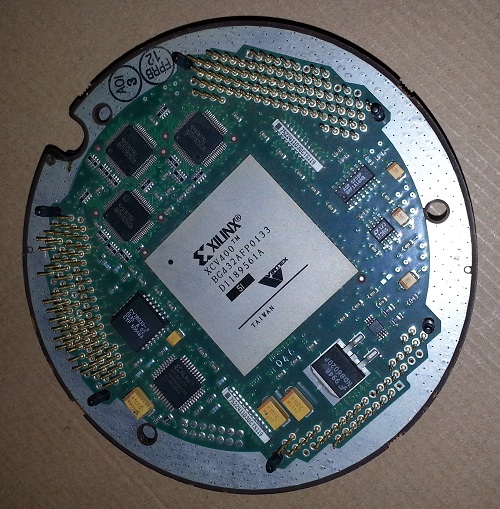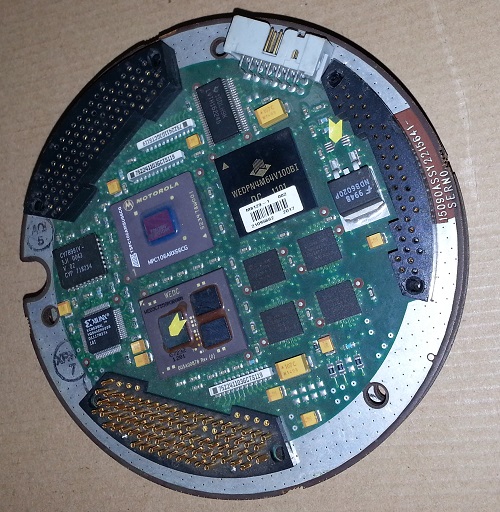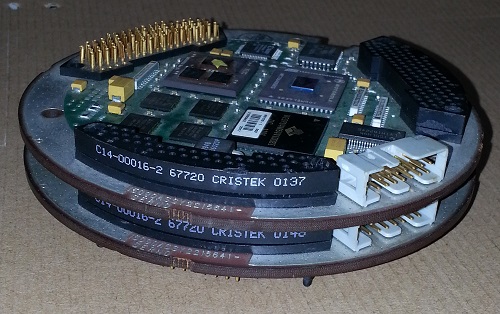The Ware for March 2014 is shown below.
I came across this at a gray market used parts dealer in Shenzhen. Round, high density circuit boards with big FPGAs and ceramic packages tend to catch my eye, as they reek of military or aerospace applications.
I have no idea what this ware is from, or what it’s for, so it should be interesting judging the responses — if there is no definitive identification, I’ll go with the most detailed/thoughtful response.



Hmm. Low power, high throughput with fairly standard components that have gone through a lot of space/design optimization.
My guess is a video/media signal interface for a transmission tower.
What are Atmel and Motorola logos both doing on a single chip? And I don’t recognize the logo of the chip “WEDPN…”.
So the receptacle side has a RISC CPU (WEDC3…), PCI interface (Atmel/Motorola), Synchronous DRAM (White Electronic Designs Corporation WEDPN…), and some small surface mount chips, possibly flash but too small to read the markings. Other chips include a CPLD and a clock generator.
The pin side has a FPGA (Virtex 2.5V, dating to ’98), a chip to store the FPGA bitstream, and some chips to facilitate snooping the buses via JTAG (ABTH182502A).
The stacking connector design puts me in mind of PC-104 but obviously this isn’t that.
I dunno what it was for (nothing I spotted seems to imply a singular use), but maybe you should have picked it up to run cryptocurrency mining on that FPGA. :-P
Besides what Jeff said about the components, the connectors seem to be Cristek Press-Fit connectors, a similar shaped connector can be seen at the product catalog sheet. Also it states that there are MIL-SPEC types available.
Thinking that ceramic packages, CPU + FPGA, MIL-SPEC parts, circular board that is stackable makes me think that this board is from some sort of missile. All other boards I’ve seen that were manufactured for military were rectangular, even though they were meant to be stacked. Some sort of radar data processing board also comes to mind but these units don’t have the processing directly behind the antenna so I’ll skip that too.
The reason I’m saying a board from a missile is that I’ve only seen circular boards on missiles. Also to help with putting lots of stuff inside a tight space, they use stacked configuration like this. Other types of modules usually use a backbone + daughterboards mounted with high-speed mixed signal connectors. Also they don’t have connectors on board as much as possible: Connectors for communicating with other modules are put on the module box and cables connecting them are directly soldered on the PCBs for ruggedness.
The WEDC part is an early rev of an Atmel branded PowerPC 755 with L2 MCM (cool, I didn’t know that Atmel had done PowerPC chips), packaged by WEDC http://www.datasheetlib.com/datasheet/288142/pc755bm8_atmel-corporation.html http://pdf.datasheetarchive.com/indexerfiles/gl/Datasheet-025/DSA00434715.pdf
I’m with the others, missile guidance computer.
Also, I assume the two boards are the same?
A Gsm relay module ?
Stack more to handle more simultanous comms…
Or a parallel RSA cracking (or bitcoin mining) module ?
Missile/torpedo is a good option too.
With the big FPGA, all these seem credible.
Didn’t do the maths, but the diameter should be around 10-12cms
(4″ for people who don’t get the SI units ;-)
Definitely not a torpedo, that would have been my first guess (specifically a ’21” autonomous underwater vehicle’) but it’s not nearly big enough for that. Now there are smaller ones like the Mk.46 and Mk.48 at 12.75″, but the board looks too small even for that. It also just doesn’t look military, it’s all civilian parts, no conformal coating on the PCB, etc.
OK, cancel the “not military” comment, I hadn’t looked a the second photo. It’s still a bit unusual to see what look like standard PLCCs rather than the usual sea of ceramic though.
Based on the information on page 14 here:
http://datasheet.octopart.com/WED3C7410E16M-400BH9M-Microsemi-datasheet-13695799.pdf
The chip with the “WED3C7558M3008M” looks like it’s a PowerPC 755, 8Mbits L2 cache, 300 MHz, Military Screened.
Similar to these defense electronics:
http://www.defencegreece.com/index.php/2011/09/intracom-defense-electronics-expands-its-cooperation-with-raytheon-missile-systems-with-a-1-9-million-contract/
?
Modular with consistent axial direction connectors between modules.
About 4″ diameter says Steve.:)
I’m gonna go with oilfield down well sensor processing / telemetry device.
It seems like the boards have a layer of clear encapsulant over them and the outer circumference looks structurally reinforced; for rough and dirty use.
The large space and weight devoted to connectors alone seems inconsistent with a one time use item like a missile.
If it is oilfield, it was probably made inhouse by Schlumberger, Bechtel or the like for their own use exclusively with no intention of ever selling it to anyone else. That could explain the absence of any marks identifying what it is and who it came from.
One quick question… does it smell oily?
Woah there. Those guessing missile system component are probably correct.
That “15090” looked suspiciously like a CAGE code (http://en.wikipedia.org/wiki/Cage_code), so I punched it into the search at https://www.logisticsinformationservice.dla.mil/BINCS/begin_search.aspx
It yields the Tucson division of one large defense contractor, let’s say “R”, which is known for missiles. My hope is that this was part of an U.S.-exportable system, but a federal agency might be interested in knowing where you found this kit.
Through me, the Electrolab Hackerspace guesses that this ware probably comes from a CCD camera.
following CAGE lead , and the R result, considering cristek is specialized in aerospatial and mil product, i found this http://www.ipcbdesign.com/PCB%20Assembly.htm looks similar but older design , same components lines and R* company mention in the JPG filename. Rely to the same filename , i found SM3 is related to Aegis Ballistic Missile Defense System SM3 missile https://en.wikipedia.org/wiki/RIM-161_Standard_Missile_3, the “LEAP” part of the filename related to Lightweight Exo-Atmospheric Projectile. Definitly part of a missile for me, but why not as told by f4grx, from the vision system. Keep working on this.
i’ve finished to understand the last part of the filename : “_ASP_DP_Released” , DP = Dynamic positioning and ASP = (Kinetic Warhead) Advanced Signal Processor (ASP) according to http://www.globalsecurity.org/space/systems/sm3-upgrades.htm and http://www.awamarine.com.au/products.asp?cid=6 , so i guess it is a board for it. How much it cost on the gray market ? Could be an interesting development kit :P
The guy wanted 1000 RMB — too pricey for a coffee table centerpiece, imo. I’m pretty sure it’s non-functional, the yellow sticker arrows were probably left over by a tech who noted bad parts; the board was tossed in the trash and eventually ended up in the used parts market.
I’m going to guess missile too… isn’t it a little sad that those boards were designed for a highly complex machine whose only purpose is to destroy and be destroyed?
To me, it seems to be like a ROCKET guidance system!
PowerPC, round… prototype MacPro? :-)
I’m going to take a couple of leaps here and say the atmel was a controller for sensors and the motorola chip is for radio comms, and the fpga is for some type of top secret hardware, that makes deplyment easier and the obfuscation of the design. My guess, I think the stack design is for redundancy in case one of the chips/boards goes bad, not for parallel executions of some sort. Plus if the assumption is that this board went bad in the line of duty, it couldn’t be used for a destructive purpose. Plus if the assumption is the board was diagnosed, you have to have enough time, money, and expertise to diagnose the specific problem circuits, which means either the boards are mission critical, expensive to replace, or labor is free and expertise is trained such as military contracts or soldiers respectively. Maybe some type of portable computer used in military vehicles for surveillance, or field transmissions decoder, I’m curious to know.
Have to post this anonymously (I did rework on this sort of kit about 12 years ago but not this specific product) but these look like AIM-120C-7 guidance system MC boards. They mount all the heavy stuff like the CERDIP packages forward facing so that the acceleration doesn’t rip them off the board (F=ma hurts these boards). The sensor and analogue front end stacks on top and the RF front end stuff stacks on top of that. The power regulation goes behind it and the power bus runs in that little notch on the side.
These ain’t cheap. Probably around $5000 a board to knock out, are stuffed with expensive MIL-SPEC components and probably still have firmware on them.
Also these probably should have been incinerated rather than work their way onto the open market. Parts on the market is fine but assemblies is likely to result in them being descended on and the parts confiscated.
I’m on the SM-3 boat…diameter is about right, and the components are classic R* for the task at hand.
The tantalums look like the high-rel COTS/Mil-Aero series from AVX or Kemet to boot; those resistor arrays look like 22R series resistors, perfect for usage as part of a PCI bus.
3 JTAG scan devices is kinda odd though; if they are anything like the SN74LVTH182652A it’s an 18-bit (2x 9-bit halves) test controller that can do a wide variety of things. Perhaps used extensively when personnel are running tests from the ground?
It looks from the components like it might be a telemetry board from an air-to-air missile, probably an AIM. What’s the diameter of the boards? It looks like they’re around 6 inches?
Obviously I’m not the first, but maybe this is the only clear evidence. These circuits are from the guidance section of an AIM9 Sidewinder air-to-air missile. Here’s a photo of the next generation:
http://force-eng.com/yahoo_site_admin/assets/images/AIM-9X.273130800_std.JPG
I think the file name says enough.
hot damn. Now I want to go buy the thing and extract the firmwares from the ROMs.
Oh shit, Bunnie you have some serious stuff on your hands. This is so cool.
Those who guessed rockets, guidance Systems are never constructed that way, in no Country and you won’t find These components for These purposes in Shenzen.
Looking at the configuration and orientation of the components it is a rest of a modular prototype for telemetry , designed for use in space. A simple Piece of some Satellite.
This looks like its a pretty interesting find:
http://componentsearch.com/search/searchResults?keyword=WED3C755